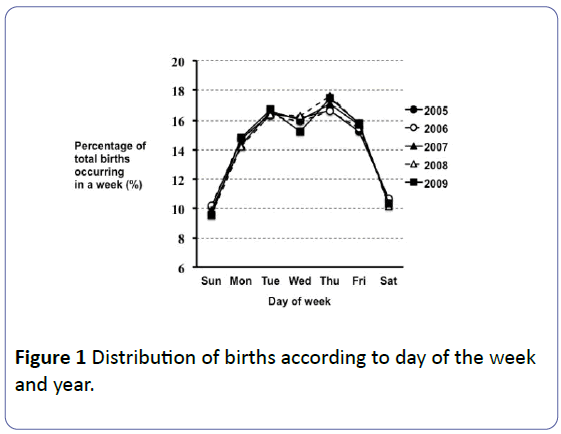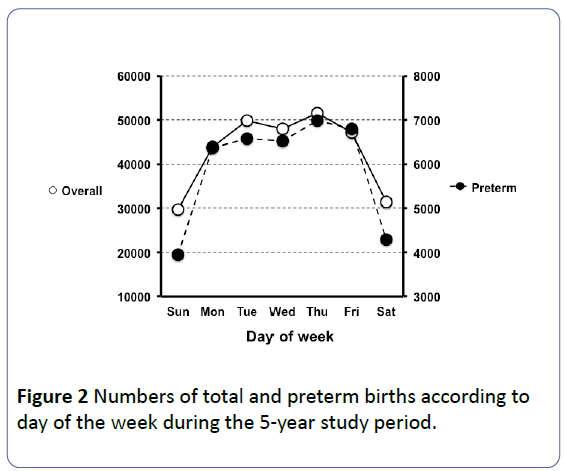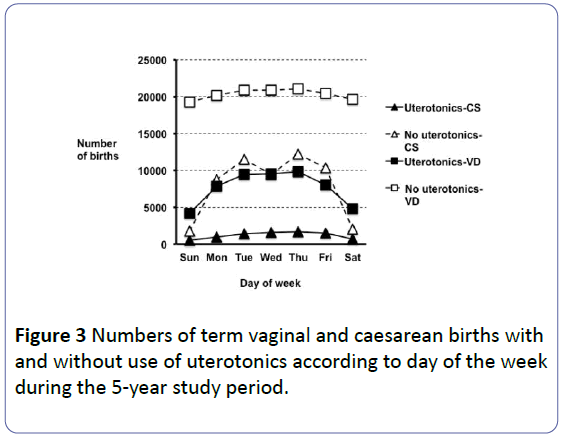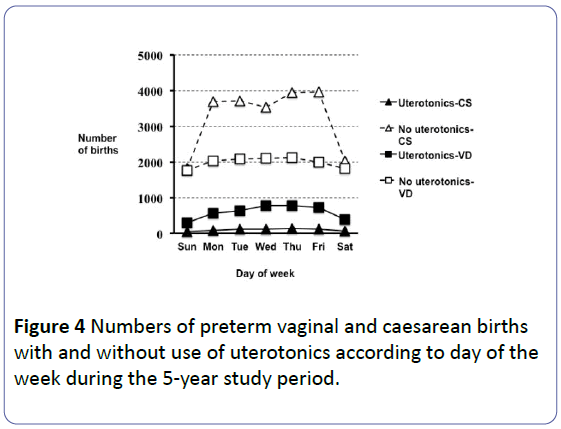Perinatal Mortality Rate in Weekend Birth in Japan
Mamoru Morikawa, Takahiro Yamada, Kentaro Chiba, Ami Hosokawa, Shoji Sato, Satoshi Ishikawa and Hisanori Minakami
DOI10.21767/2471-9803.100031
1Department of Obstetrics, Hokkaido University School of Medicine, Sapporo, Japan
2Maternal and Perinatal Care Center, Oita Prefectural Hospital, Bunyo 476, Oita 870-8511, Japan
- Corresponding Author:
- Hisanori Minakami
Department of Obstetrics
Hokkaido University Graduate School of Medicine
N14 W6, Kita-ku, Sapporo, Japan
Tel: +81117066051
Fax: +81117066932
E-mail: minasho@med.hokudai.ac.jp
Received Date: July 28, 2016; Accepted Date: August 22, 2016; Published Date: September 02, 2016
Citation: Morikawa M, Yamada T, Chiba K, et al. Perinatal mortality rate in weekend birth in Japan. Crit Care Obst&Gyne. 2016, 2:4. doi:10.4172/2471-9803.1000131
Copyright: © 2016 Morikawa M et al. This is an open-access article distributed under the terms of the Creative Commons Attribution License, which permits unrestricted use, distribution, and reproduction in any medium, provided the original author and source are credited.
Abstract
Background: It was unknown whether risk of perinatal mortality rate (PMR) was higher in weekend than week days births in Japan and how Japanese obstetricians attempted to reduce numbers of weekend births.
Methods and Findings: Retrospective observational study on 301510 women registered in the Japan Society of Obstetrics and Gynecology registry system who gave birth to singleton infants at gestational week ≥ 22 between 2005 and 2009. The proportion of women giving birth vaginally vs. by caesarean section with and without uterotonics was determined according to day of the week. Perinatal mortality included stillbirth and early neonatal death within one week after live birth occurring on and after gestational week 22. The PMR was similar between weekdays and weekend births (2.0% [4898/240455] vs. 2.0% [1217/61055], respectively). The fractions of Sunday and Thursday births were smallest and largest, respective; the mean ± SD fractions of Saturday and Sunday births were 10.4 ± 0.2% and 9.9 ± 0.3%, respectively, while those of Monday, Tuesday, Wednesday, Thursday, and Friday births were 14.6 ± 0.3%, 16.5 ± 0.2%, 15.9% ± 0.4%, 17.1% ± 0.4%, and 15.6% ± 0.3% of all 301510 births, respectively. The numbers of vaginal births with uterotonics and of caesarean births per day were approximately double and ~3.6-fold greater for weekdays than for those for weekend, respectively.
Conclusions: The PMR did not differ between births that occurred on weekdays and weekend. Frequent uterotonic use and caesarean delivery on weekdays explained the disproportionately reduced number of weekend births.
Keywords
Induced labor; Weekend birth; Weekdays birth; Uterotonics; Elective caesarean section
Introduction
In Japan, approximately 1100000 women give birth annually at 2800 facilities, at which approximately 8000 obstetricians are employed [1]. Thus, the average number of obstetricians is less than 3 per facility, and the annual number of births is less than 400 per facility in Japan at present. The onset of labor pains, rupture of the, and delivery can occur at any time of the day and on any day of the week, even with the small number of births per facility. As 99% of all 1100000 deliveries are managed at obstetric facilities [2] in which obstetricians are expected to be in attendance in Japan, this situation may be associated with heavy workload for Japanese obstetricians.
In many countries, the number of weekend births decreased in the 20th century [3-11]. According to information released by the Japanese Ministry of Health, Labour, and Welfare, there were 25% and 30% fewer hospital births on Saturdays and national holidays (including Sundays), respectively, than on weekdays in 2000 in Japan.
As some reports indicated that the outcomes of weekend births are unfavorable compared to those on weekdays [7-13], Japanese obstetricians may have attempted to reduce the number of births on weekends. However, there have been no reports regarding how Japanese obstetricians attempted to control the numbers of births according to the day of the week. Accordingly, we performed this retrospective study using data of women with singleton pregnancies who participated in the registry system established by the Japan Society of Obstetrics and Gynecology (JSOG) to determine number of women with vaginal and caesarean deliveries with and without the use of uterotonics according to day of the week.
Materials and Methods
This study was approved by the Ethics Committee of Hokkaido University Hospital. Approximately 120 secondary and tertiary hospitals participated in the JSOG Successive Pregnancy Birth Registry System, which collected information on successive deliveries that occurred at ≥22 weeks of gestation in these hospitals. The available information from this system included maternal age, parity, gestational week at delivery, birth date, sex of infant, birth weight, live-born/ stillborn, early neonatal death within 7 days of life, delivery mode, use of uterotonics, and maternal complications, such as eclampsia, pregnancy-induced hypertension (including gestational hypertension and preeclampsia), and placental abruption. A total of 302795 women with singleton pregnancies were registered in this system over the 5-year period between 2005 and 2009, corresponding to approximately 5.6% of all singleton pregnancies in Japan during this period. Of these, 301510 women were analyzed in this study after excluding 1060 women (0.35%) whose age, gestational week at delivery, and/or parity were unknown and 225 women with eclampsia.
Statistical analyses were performed using the statistical software package StatView 5.0 for Macintosh (SAS Institute Inc., Cary, NC, USA) and IBM SPSS Statistics 18.0 software (SPSS Inc., Chicago, IL, USA). All data are presented as means ± SD. The unpaired t test and Mann–Whitney U test were used to analyze the results. Fisher’s exact test was used to compare the frequencies. In all analyses, P<0.05 was taken to indicate statistical significance.
Results
The annual number of births analyzed in this study did not differ markedly over the 5-year study period, ranging from 52077 to 69910 (Table 1). Of the 301510 women included in the present study, 66684 (22.1%) women used uterotonics, including oxytocin and prostaglandins F2α and E2, 87454 (29.0%) underwent caesarean delivery, and 41483 (13.8%) gave birth at preterm before 37 weeks of gestation (Table 1). Weekend births accounted for 20.2% of all 301510 births, which was lower than the expected figure, 28.6% (2 in 7), if we assumed that the number of births according to day of the week would have an even distribution.
| Number of women analyzed | 301510 |
| 2005 | 52077 |
| 2006 | 57864 |
| 2007 | 57849 |
| 2008 | 63810 |
| 2009 | 69910 |
| Nulliparity | 158552 (52.6%) |
| Age (year) | 31.4 ± 5.1 |
| Use of uterotonics*ÃÆââ¬Å¡ÃâàÃÆââ¬Å¡ÃâàÃÆââ¬Å¡ÃâàÃÆââ¬Å¡Ãâà| 66684 (22.1%) |
| Gestational week at delivery | 39 (22 - 43) |
| Preterm (<37 weeks) | 41483 (13.8%) |
| Caesarean delivery | 87454 (29.0%) |
| Weekend births† | 61055 (20.2%) |
| *:Including oxytocin and prostaglandin F2 α and E2, † :Births on Saturday and Sunday. | |
Table 1: Demographic characteristics.
The distribution of births according to day of the week did not vary over the 5 years included in the study (Figure 1). The fractions of Sunday and Thursday births were smallest and largest, respectively, in any year. The mean (SD) fractions of Saturday and Sunday births were 10.4% (0.2%) and 9.9% (0.3%), respectively, while those of Monday, Tuesday, Wednesday, Thursday, and Friday births were 14.6% (0.3%), 16.5% (0.2%), 15.9% (0.4%), 17.1% (0.4%), and 15.6% (0.3%) of all 301510 births, respectively.
Thus, the number of births, including preterm births, occurring on Saturdays or Sundays was approximately 30000, accounting for 60% of the number on weekdays (50000) during the study period (Figure 2). The number of preterm births on Saturdays or Sundays was approximately 4000, while and that on weekdays was approximately 6600 during the study period (Figure 2). However, the fraction of preterm births among the total births did not vary significantly according to day of the week: 13.3% on Sunday, 14.5% on Monday, 13.2% on Tuesday, 13.6% on Wednesday, 13.5% on Thursday, 14.4% on Friday, and 13.6% on Saturday.
Among term births, the number of vaginal births with use of uterotonics on weekdays (approximately 8900) was approximately double those (approximately 4500) on Saturdays or Sundays (Figure 3). The number of caesarean births without use of uterotonics at term on weekdays (approximately 10400) was approximately 5.5-fold greater than those (1900) on Saturdays or Sundays, while that of births with use of uterotonics on weekdays (approximately 1400) was approximately 2.3-fold greater than those (approximately 600) on Saturdays or Sundays. Thus, the total number of caesarean births on weekdays (approximately 11800) was approximately 4.7-fold greater than those (2500) on Saturdays or Sundays. Although the absolute number of preterm births was smaller than that of term births, a similar trend to that of term births was seen for preterm births regarding the frequency of vaginal births with use of uterotonics and caesarean births according to day of the week (Figure 4). In contrast, the numbers of term or preterm births without use of uterotonics did not vary greatly according to day of the week (Figures 3 and 4, Table 2).
| Total number of births (per day) during 5 years | |||
|---|---|---|---|
| Weekdays | Weekends | Net difference | |
| All births | 240455 (48091) | 61055 (30528) | 179400 (17563) |
| Vaginal births | |||
| Without uterotonics | 113775 (22755) | 42506 (21253) | 71269 (1502) |
| With uterotonics | 48110 (9618) | 9665 (4833) | 38445 (4785) |
| Caesarean delivery | 78570 (15714) | 8884 (4442) | 69686 (11272) |
| *: Deaths within 7 days of life. | |||
Table 2: Numbers of births by delivery mode during the 5-year study period.
The difference in total number of births occurring on weekdays and weekends was 179400 (Table 2). Vaginal births with use of uterotonics accounted for 21.4% (38445/179400) and caesarean births accounted for 38.8% (69686/179400) of the net difference of total births occurring on weekdays and weekends (Table 2). Thus, the decrease in number of weekend births was mainly attributable to the decreased use of uterotonics and caesarean deliveries at weekends.
Infant outcome, with regard to risk of stillbirth and early neonatal death, did not differ between births occurring on weekdays and on weekends in either term or preterm births in this study (Table 3).
Discussion
Although expected, this study demonstrated for the first time that Japanese obstetricians reduced the number of weekend births through increasing the number of weekday births with the frequent use of uterotonics and caesarean deliveries. This may have been associated with the similar perinatal mortality rate between weekdays and weekend births.
The decline in Sunday births dates to the 1930s, and the decline in Saturday births dates to the 1950s, according to data abstracted from Midwestern Health Maintenance Organization in the USA, coinciding with a sharp decline in home births beginning in the late 1930s and continuing into the 1990s [4], followed by rising rates of labor induction in the USA [14]. In women with term pregnancies who experienced spontaneous onset of labor, births are randomly distributed throughout the week [15], indicating that there is no natural association between spontaneous birth and the day of the week. Based on these data, the non-random birth patterns, i.e., disproportionately larger numbers of weekday births and smaller numbers of weekend births, documented in Australia, Canada, Germany, Switzerland, the UK, and the USA [3-11] have been considered to be due to elective interventions, such as elective induction of labor and elective caesarean section on weekdays. It is reasonable to expect care providers to plan caesarean deliveries and elective induction of labor during weekdays when adequate staff are available in contrast to the weekend period. However, direct evidence supporting this hypothesis was lacking, although a significant correlation was demonstrated between caesarean section rate and weekend birth avoidance rates, i.e., larger numbers of caesarean births are associated with fewer weekend births [3,6,8]. No studies have addressed the association between labor induction rate and weekend birth avoidance rate.
This study demonstrated that the daily numbers of caesarean births and vaginal births with use of uterotonics were smaller on weekends than on weekdays by 72% and by 50%, respectively. Although the dataset in this study lacked information regarding whether the caesarean was elective vs. emergency and whether use of uterotonics was for augmentation of labor or elective induction of labor, some caesarean births should have been elective and some vaginal births with use of uterotonics should have resulted from elective induction of labor. These elective interventions on weekdays may have contributed to the disproportionately larger number of weekday births, resulting in a decrease in weekend births. This was further supported by the observation that both term and preterm births without use of uterotonics were randomly distributed throughout the week (Figures 3 and 4) compared with caesarean births and vaginal births with use of uterotonics.
In this study, weekend births were not associated with adverse infant outcomes. However, unfavorable outcomes have been reported previously for infants born on weekends [7-13]. As low staffing levels and reduced hospital efficiency during weekends have been suggested to be the cause of increased weekend mortality as compared to weekdays outside of obstetrics [16], these factors may contribute to the higher risk of adverse outcomes associated with weekend births. However, this may not be the case. For example in a study by Gould et al. [8] examining 1615041 live births (weight ≥ 500 g) in California, the proportion of births on weekends was 17.5% lower than that on weekdays, and weekend decreases in births were least pronounced in smaller infants, resulting in a weekend concentration of high mortality among very low birth weight (<1500 g) births. After adjusting for birth weight, the increased odds of death for infants born on the weekend were no longer significant [8]. In another study conducted in Canada [7] examining 3239972 births, the proportion of births on weekends was 24% lower than that on weekdays. Infants born on weekends had slightly but significantly elevated risks of stillbirth (relative risk [RR], 1.06; 95% confidence interval [CI], 1.02 – 1.09) and early neonatal death (RR, 1.11; 95% CI, 1.07 - 1.16). However, the higher risks disappeared after adjustment for gestational age [7]. In a recent study by Gijsen et al. in the Netherlands [17] focusing on the relationship between off-hours delivery (weekends, evenings, or at night) and adverse perinatal outcomes among 903212 women, analyses were performed after excluding approximately 50% of women who were likely to have adverse outcome because of various risk factors. Although evening and nighttime deliveries that involved induction or augmentation of labor, or emergency caesarean section, were associated with increased risk of adverse perinatal outcome when compared to similar daytime deliveries, weekend deliveries were not associated with increased risk when compared to weekday deliveries [17].
Our study had the limitation that as almost all institutions participating in the JSOG Successive Pregnancy Birth Registry System are secondary or tertiary hospitals, the fraction of high-risk women may have been greater than that in the general Japanese population in this study. Indeed, preterm births occurred in 13.8% of the women in this study, far exceeding the actual incidence of 5.7% - 5.8% during the study period in Japan [2]. This implied that some women with preterm deliveries were referred from local facilities after onset of premature labor even on weekends. This study showed that women with referral on weekends were treated adequately, although the care manager system that creates a strong collaboration between primary physicians, secondary/ tertiary hospitals, and patients [18] was not available in Japan. In addition, this was a retrospective and observational study. However, as this study included a relatively large number of women, this study may have not distorted a phenomenon occurring in Japan.
In conclusion, the perinatal mortality rate was similar between weekdays and weekend births. The number of vaginal births with use of uterotonics on weekdays was approximately double those on Saturdays or Sundays. The number of caesarean births on weekdays was approximately 3.6-fold greater than those on Saturdays or Sundays. Thus, the frequent use of uterotonics and caesarean delivery on weekdays explained the disproportionately reduced number of weekend births.
References
- Minakami H, Hiramatsu Y, Koresawa M, Fujii T, Hamada H, et al. (2011) Guidelines for obstetrical practice in Japan: Japan Society of Obstetrics and Gynecology (JSOG) and Japan Association of Obstetricians and Gynecologists (JAOG) 2011 edition. J ObstetGynaecol Res 37:1174-1197.
- Kamiya K,Editorial assistance provided by Mothers’ & Children’s Health & Welfare Associationm(2012) Maternal and Child Health Statistics of Japan. Tokyo: Mothers’ & Children’s Health Organization.
- Lerchl A (2008) Where are the Sunday babies? III. Caesarean sections, decreased weekend births, and midwife involvement in Germany. Naturwissenschaften 95:165-170.
- Goodman MJ, Nelson WW, Maciosek MV (2005) Births by day of week: a historical perspective. J Midwifery Womens Health 50:39-43.
- Lerchl A (2005) Where are the Sunday babies? Observations on a marked decline in weekend births in Germany. Naturwissenschaften 92:592-594.
- Lerchl A, Reinhard SC(2008) Where are the Sunday babies? II. Declining weekend birth rates in Switzerland. Naturwissenschaften 95:161-164.
- Luo ZC, Liu S, Wilkins R, Kramer MS (2004) Risks of stillbirth and early neonatal death by day of week. CMAJ 170:337-341.
- Gould JB, Qin C, Marks AR, Chavez G (2003) Neonatal mortality in weekend vs weekday births. JAMA 289:2958-2962.
- Hendry RA (1981) The weekend-a dangerous time to be born? Br J ObstetGynaecol 88:1200-1203.
- MacFarlane A (1978) Variations in number of births and perinatal mortality by day of week in England and Wales. Br Med J 2:1670-1673.
- Mathers CD (1983) Births and perinatal deaths in Australia: variations by day of week. J Epidemiol Community Health 37:57-62.
- Hamilton P, Restrepo E (2003) Weekend birth and higher neonatal mortality: a problem of patient acuity or quality of care? JOGNN 32:724-733.
- Salihu HM, Ibrahimou B, August EM, Dagne G (2012) Risk of infant mortality with weekend versus weekday births: a population-based study. J ObstetGynaecol Res 38:973-979.
- Rayburn WF, Zhang J (2002) Rising rates of labor induction: present concerns and future strategies. ObstetGynecol 100:164-167.
- Mancuso PJ, Alexander JM, McIntire DD, Davis E, Burke G, et al. (2004) Leveno KJ. Timing of birth after spontaneous onset of labor. ObstetGynecol 103:653-656.
- Ecker DJ (2007) Quality of care and mortality. Do hospitals provide lower quality care on weekends? Health Serv Res 42:1589-1612.
- Gijsen R, Hukkelhoven CW, Schipper CM, Ogbu UC, de Bruin-Kooistra M, et al. (2012) Effects of hospital delivery during off-hours on perinatal outcome in several subgroups: a retrospective cohort study. BMC Pregnancy and Childbirth.
- Ciccone MM, Aquilino A, Cortese F, Scicchitano P, Sassara M, et al. (2010) Mola E, Rollo R, Caldarola P, Giorgino F, Pomo V, Bux F. Feasibility and effectiveness of a disease and care management model in the primary health care system for patients with heart failure and diabetes (Project Leonardo). Vasc Health Risk Manag 6:297-305.
Open Access Journals
- Aquaculture & Veterinary Science
- Chemistry & Chemical Sciences
- Clinical Sciences
- Engineering
- General Science
- Genetics & Molecular Biology
- Health Care & Nursing
- Immunology & Microbiology
- Materials Science
- Mathematics & Physics
- Medical Sciences
- Neurology & Psychiatry
- Oncology & Cancer Science
- Pharmaceutical Sciences




